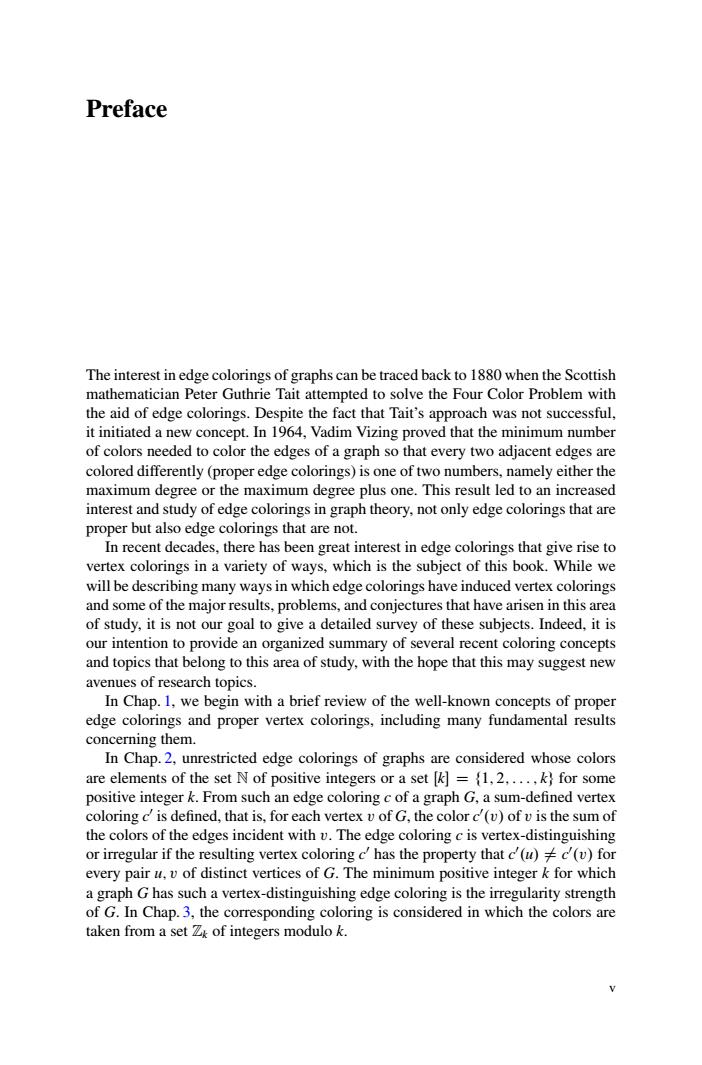正在加载图片...

Preface The interest inedge colorings of graphs can be traced back to 1880 when the Scottish mathematician Peter Guthrie Tait attempted to solve the Four Color Problem with the aid of edge colorings.Despite the fact that Tait's approach was not successful. it initiated a new concept.In 1964,Vadim Vizing proved that the minimum number of colors needed to color the edges of a graph so that every two adjacent edges are ly (popedec)one of This 之二onl In recent decades,there has been great interest in edge colorings that give rise to vertex colorings in a variety of ways,which is the subject of this book.While we will be describing many ways in which edge colorings have induced vertex colorings he major results.problems,and conjectures that have arisen in our goal to give a detailed survey of these subjects.Indeed.it is our intention to of s nt colo avenues of research topics In Chap.1,we begin with a brief review of the well-known concepts of proper edge colorings and proper vertex colorings,including many fundamental results concerning them. In Chap.2,unrestricted edge colorings of graphs are considered whose colors the setNof positive int gers or a set[=1.2.....k for some such an edge colo h G a sum-defined ver is defined olor()ofv is the st of the edges inciden The dge coloring cis or irregular if the resulting vertex coloring chas the property that c() every pair u.v of distinct vertices of G.The minimum positive integer k for which a graph G has such a vertex-distinguishing edge coloring is the irregularity strength of G.In Chap.3,the corresponding coloring is considered in which the colors are taken from a set Z of integers modulo k.Preface The interest in edge colorings of graphs can be traced back to 1880 when the Scottish mathematician Peter Guthrie Tait attempted to solve the Four Color Problem with the aid of edge colorings. Despite the fact that Tait’s approach was not successful, it initiated a new concept. In 1964, Vadim Vizing proved that the minimum number of colors needed to color the edges of a graph so that every two adjacent edges are colored differently (proper edge colorings) is one of two numbers, namely either the maximum degree or the maximum degree plus one. This result led to an increased interest and study of edge colorings in graph theory, not only edge colorings that are proper but also edge colorings that are not. In recent decades, there has been great interest in edge colorings that give rise to vertex colorings in a variety of ways, which is the subject of this book. While we will be describing many ways in which edge colorings have induced vertex colorings and some of the major results, problems, and conjectures that have arisen in this area of study, it is not our goal to give a detailed survey of these subjects. Indeed, it is our intention to provide an organized summary of several recent coloring concepts and topics that belong to this area of study, with the hope that this may suggest new avenues of research topics. In Chap. 1, we begin with a brief review of the well-known concepts of proper edge colorings and proper vertex colorings, including many fundamental results concerning them. In Chap. 2, unrestricted edge colorings of graphs are considered whose colors are elements of the set N of positive integers or a set Œk D f1; 2; : : : ; kg for some positive integer k. From such an edge coloring c of a graph G, a sum-defined vertex coloring c0 is defined, that is, for each vertex v of G, the color c0 .v/ of v is the sum of the colors of the edges incident with v. The edge coloring c is vertex-distinguishing or irregular if the resulting vertex coloring c0 has the property that c0 .u/ ¤ c0 .v/ for every pair u; v of distinct vertices of G. The minimum positive integer k for which a graph G has such a vertex-distinguishing edge coloring is the irregularity strength of G. In Chap. 3, the corresponding coloring is considered in which the colors are taken from a set Zk of integers modulo k. v�